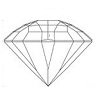4.3: The Chemical Classification of Gems and Minerals
- Page ID
- 3188
\( \newcommand{\vecs}[1]{\overset { \scriptstyle \rightharpoonup} {\mathbf{#1}} } \)
\( \newcommand{\vecd}[1]{\overset{-\!-\!\rightharpoonup}{\vphantom{a}\smash {#1}}} \)
\( \newcommand{\id}{\mathrm{id}}\) \( \newcommand{\Span}{\mathrm{span}}\)
( \newcommand{\kernel}{\mathrm{null}\,}\) \( \newcommand{\range}{\mathrm{range}\,}\)
\( \newcommand{\RealPart}{\mathrm{Re}}\) \( \newcommand{\ImaginaryPart}{\mathrm{Im}}\)
\( \newcommand{\Argument}{\mathrm{Arg}}\) \( \newcommand{\norm}[1]{\| #1 \|}\)
\( \newcommand{\inner}[2]{\langle #1, #2 \rangle}\)
\( \newcommand{\Span}{\mathrm{span}}\)
\( \newcommand{\id}{\mathrm{id}}\)
\( \newcommand{\Span}{\mathrm{span}}\)
\( \newcommand{\kernel}{\mathrm{null}\,}\)
\( \newcommand{\range}{\mathrm{range}\,}\)
\( \newcommand{\RealPart}{\mathrm{Re}}\)
\( \newcommand{\ImaginaryPart}{\mathrm{Im}}\)
\( \newcommand{\Argument}{\mathrm{Arg}}\)
\( \newcommand{\norm}[1]{\| #1 \|}\)
\( \newcommand{\inner}[2]{\langle #1, #2 \rangle}\)
\( \newcommand{\Span}{\mathrm{span}}\) \( \newcommand{\AA}{\unicode[.8,0]{x212B}}\)
\( \newcommand{\vectorA}[1]{\vec{#1}} % arrow\)
\( \newcommand{\vectorAt}[1]{\vec{\text{#1}}} % arrow\)
\( \newcommand{\vectorB}[1]{\overset { \scriptstyle \rightharpoonup} {\mathbf{#1}} } \)
\( \newcommand{\vectorC}[1]{\textbf{#1}} \)
\( \newcommand{\vectorD}[1]{\overrightarrow{#1}} \)
\( \newcommand{\vectorDt}[1]{\overrightarrow{\text{#1}}} \)
\( \newcommand{\vectE}[1]{\overset{-\!-\!\rightharpoonup}{\vphantom{a}\smash{\mathbf {#1}}}} \)
\( \newcommand{\vecs}[1]{\overset { \scriptstyle \rightharpoonup} {\mathbf{#1}} } \)
\( \newcommand{\vecd}[1]{\overset{-\!-\!\rightharpoonup}{\vphantom{a}\smash {#1}}} \)
\(\newcommand{\avec}{\mathbf a}\) \(\newcommand{\bvec}{\mathbf b}\) \(\newcommand{\cvec}{\mathbf c}\) \(\newcommand{\dvec}{\mathbf d}\) \(\newcommand{\dtil}{\widetilde{\mathbf d}}\) \(\newcommand{\evec}{\mathbf e}\) \(\newcommand{\fvec}{\mathbf f}\) \(\newcommand{\nvec}{\mathbf n}\) \(\newcommand{\pvec}{\mathbf p}\) \(\newcommand{\qvec}{\mathbf q}\) \(\newcommand{\svec}{\mathbf s}\) \(\newcommand{\tvec}{\mathbf t}\) \(\newcommand{\uvec}{\mathbf u}\) \(\newcommand{\vvec}{\mathbf v}\) \(\newcommand{\wvec}{\mathbf w}\) \(\newcommand{\xvec}{\mathbf x}\) \(\newcommand{\yvec}{\mathbf y}\) \(\newcommand{\zvec}{\mathbf z}\) \(\newcommand{\rvec}{\mathbf r}\) \(\newcommand{\mvec}{\mathbf m}\) \(\newcommand{\zerovec}{\mathbf 0}\) \(\newcommand{\onevec}{\mathbf 1}\) \(\newcommand{\real}{\mathbb R}\) \(\newcommand{\twovec}[2]{\left[\begin{array}{r}#1 \\ #2 \end{array}\right]}\) \(\newcommand{\ctwovec}[2]{\left[\begin{array}{c}#1 \\ #2 \end{array}\right]}\) \(\newcommand{\threevec}[3]{\left[\begin{array}{r}#1 \\ #2 \\ #3 \end{array}\right]}\) \(\newcommand{\cthreevec}[3]{\left[\begin{array}{c}#1 \\ #2 \\ #3 \end{array}\right]}\) \(\newcommand{\fourvec}[4]{\left[\begin{array}{r}#1 \\ #2 \\ #3 \\ #4 \end{array}\right]}\) \(\newcommand{\cfourvec}[4]{\left[\begin{array}{c}#1 \\ #2 \\ #3 \\ #4 \end{array}\right]}\) \(\newcommand{\fivevec}[5]{\left[\begin{array}{r}#1 \\ #2 \\ #3 \\ #4 \\ #5 \\ \end{array}\right]}\) \(\newcommand{\cfivevec}[5]{\left[\begin{array}{c}#1 \\ #2 \\ #3 \\ #4 \\ #5 \\ \end{array}\right]}\) \(\newcommand{\mattwo}[4]{\left[\begin{array}{rr}#1 \amp #2 \\ #3 \amp #4 \\ \end{array}\right]}\) \(\newcommand{\laspan}[1]{\text{Span}\{#1\}}\) \(\newcommand{\bcal}{\cal B}\) \(\newcommand{\ccal}{\cal C}\) \(\newcommand{\scal}{\cal S}\) \(\newcommand{\wcal}{\cal W}\) \(\newcommand{\ecal}{\cal E}\) \(\newcommand{\coords}[2]{\left\{#1\right\}_{#2}}\) \(\newcommand{\gray}[1]{\color{gray}{#1}}\) \(\newcommand{\lgray}[1]{\color{lightgray}{#1}}\) \(\newcommand{\rank}{\operatorname{rank}}\) \(\newcommand{\row}{\text{Row}}\) \(\newcommand{\col}{\text{Col}}\) \(\renewcommand{\row}{\text{Row}}\) \(\newcommand{\nul}{\text{Nul}}\) \(\newcommand{\var}{\text{Var}}\) \(\newcommand{\corr}{\text{corr}}\) \(\newcommand{\len}[1]{\left|#1\right|}\) \(\newcommand{\bbar}{\overline{\bvec}}\) \(\newcommand{\bhat}{\widehat{\bvec}}\) \(\newcommand{\bperp}{\bvec^\perp}\) \(\newcommand{\xhat}{\widehat{\xvec}}\) \(\newcommand{\vhat}{\widehat{\vvec}}\) \(\newcommand{\uhat}{\widehat{\uvec}}\) \(\newcommand{\what}{\widehat{\wvec}}\) \(\newcommand{\Sighat}{\widehat{\Sigma}}\) \(\newcommand{\lt}{<}\) \(\newcommand{\gt}{>}\) \(\newcommand{\amp}{&}\) \(\definecolor{fillinmathshade}{gray}{0.9}\)The Chemical Classification of Gems and Minerals
Gems can be organized into classes, based on their chemistry.
Table \(\PageIndex{1}\): Classes of Gems and Minerals
| Class | Description |
|---|---|
| Class I: Pure Elements | Metals, alloys, semi-metals, and non-metals |
| Class II: Sulfides | Sulfur is the principal anion: includes tellurides and arenides |
| Class III: Halides | Halogen elements are anions: F, Cl, Br |
| Class IV: Oxides | Oxygen is the principal anion, includes hydroxides in which the hydroxyl radical (OH) acts as the anion |
| Class V a:Carbonates | Carbonate radical (CO3) is the principal anion |
| Class V b:Borates | Borate radical (BO3) and borate groups are anions |
| Class VI a:Tungstates | Anions are principally WO4 |
| Class VI b:Sulphates | Sulphate radical (SO4) is the principal anion |
| Class VII: Phosphates | Anions are principally PO4 |
| Class VIII: Silicates | Silicate groups as anions combining with other elements: includes silica SiO2 |
Class I Pure Elements
Table \(\PageIndex{2}\): Pure Elements
| Class I | Pure Elements |
|---|---|
| Diamond | Carbon (C) |
Class II Sulfides
Table \(\PageIndex{3}\): Sulfides
| Class II | Sulfides |
|---|---|
| Marcasite | FeS2 |
| Pyrite | FeS2 |
| Sphalerite | ZnS |
Class IV Oxides
Table \(\PageIndex{5}\): Oxides
| Class IV | Oxides |
|---|---|
| Anatase | TiO2 |
| Brookite | TiO2 |
| Chrysoberyl | BeAl2O4 |
| Corundum | Al2O3 |
| Hematite | Fe2O3 |
| Opal | SiO2nH2O |
| Quartz | SiO2 |
| Rutile | TiO2 |
| Spinel | MgAl2O4 |
Class Va Carbonates
Table \(\PageIndex{6}\): Carbonates
| Class Va | Carbonates |
|---|---|
| Aragonite | CaCO3 |
| Azurite | Cu3(OH/CO3)2 |
| Calcite | CaCO3 |
| Cerrussite | PbCO3 |
| Malachite | Cu2(OH)2CO3 |
| Rhodochrosite | MnCO3 |
| Smithsonite | ZnCO3 |
Class Vb Borates
Table \(\PageIndex{7}\): Borates
| Class Vb | Borates |
|---|---|
| Hambergite | Be2(OH/BO3) |
| Sinhalite | MgAl(BO4) |
| Ulexite | NaCaB5O6·5H2O |
Class VIa Tungstates
Table \(\PageIndex{8}\): Tungstates
| Class VIa | Tungstates |
|---|---|
| Scheelite | Ca(WO4) |
Class VIb Sulphates
Table \(\PageIndex{9}\): Sulphates
| Class VIb | Sulphates |
|---|---|
| Barite | Ba(SO4) |
Class VII Phosphates
Table \(\PageIndex{10}\): Phosphates
| Class VII | Phosphates |
|---|---|
| Amblygonite | LiAl(F,OH/PO4) |
| Apatite | Ca5(F/PO4)2 |
| Brazilianite | NaAl3(OH2/PO4)2 |
| Turquoise | CuAl6((OH)2PO4)4·4H2O |
Class VIII Silicates
Table \(\PageIndex{11}\): Silicates
| Class VIII | Silicates |
|---|---|
| Andalusite | Al2SiO5 |
| Beryl | Be3Al2(SiO3)6 |
| Iolite (Cordierite) | Mg2Al4Si5O18 |
| Garnet | X3Y2Si3O12 (X = Mg, Fe or Ca) (Y = Al else Fe3+ or Cr) |
| Jadeite | NaAlSi2O6 |
| Nephrite | Ca2(MgFe)5(Si4O11)2 |
| Topaz | Al2SiO4(FOH)2 |
| Tourmaline | (Na1+, Ca2+)(Li1+, Mg2+, Al3+). (Al3+, Fe3+, Mn3+)6(BO3)3 (Si6O18) (OH)4 |
| Peridot | Mg2SiO4, Fe2SiO4 |
| Zircon | Zr(SiO4) |


